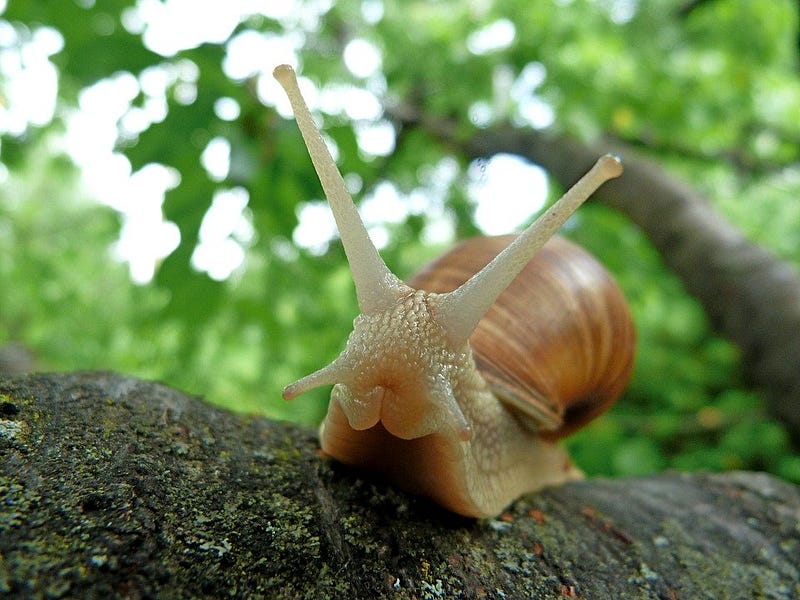Night of the Living Parasite
By Joseph Valenti, Biology, 2023

In recent years, knowledge of the “zombie snail” has become near commonplace. They are known to be small, amber snails infected with a parasite called Leucochloridium, which enters the snail through ingestion of bird feces. Once ingested, the parasite begins to grow in the antenna of the snail, and eventually branches out throughout the body. The parasite is then able to transform the snail antenna into a pulsating colorful new shape that moves in a similar fashion to caterpillars. The most interesting feature of these small organisms is that, rather than feed off its snail host, it instead changes its behavior. These changes include staying out later in the daylight, moving to higher branches, and taking away the ability to reproduce. This leaves the snail more vulnerable to bird attacks, since birds are attracted to the parasite’s caterpillar-like appearance in the antenna. They will eat the antenna of the snail, along with the parasite in the digestive tract of the bird. Finally, they will lay their eggs, which exit through feces, which allow the parasite to once again be ingested by a new snail.
The trademark behavioral change, which helps the parasite thrive in its life cycle, is certainly interesting, but its mechanisms are still rather unexplored.
The trademark behavioral change, which helps the parasite thrive in its life cycle, is certainly interesting, but its mechanisms are still rather unexplored. From what researchers already know, they are likely attributed to physical barriers rather than mind control. One physical barrier proposed is the blockage of the snail’s antenna, which heavily reduces sight, causing it to stay out later as well as travel higher in order to see the light. Another barrier is created by the parasite branching out and physically blocking the snail’s reproductive sites, causing the snail to focus more on its own preservation.
While the mechanisms behind the zombie snail’s behavioral symptoms are mostly about compensation of physical barriers, parasites are still known to cause shifts in the central nervous system of a host much closer-to-home: the human. Despite the fact that the brain is one of the most protected parts of the human body, some parasites are able to maneuver their way into it. Typically, a brain parasite will enter the body, take root in another organ and lay its eggs there. While these mechanisms are not fully understood, it is thought that the eggs can use the body’s own cells or vessels to travel to take hold in the brain.
Some parasites in human hosts have even been shown to cause behavioral changes, similar to that of the zombie snail.
Once inside the human, the parasite will interact with the brain and use its resources to best suit its survival. For example, Schistosoma haematobium and Schistosoma mansoni, two parasitic flatworms that are often transmitted through skin contact with infected water, will form parasitaemia. These are masses that induce immune responses that actually favor parasite persistence. They also synthesize biogenic amines, which allow better establishment for the parasites and helps regulate their metabolic activity. Both of these mechanisms allow the parasite to thrive in the human brain, affecting the body’s central nervous system. Another parasite, Plasmodium spp., also creates parasitaemia that decrease immune response and drive up neuroinflammation. These both also cause major stress on the host.
Some parasites in human hosts have even been shown to cause behavioral changes, similar to that of the zombie snail. One parasite, Toxoplasma gondii, increases dopamine release in infected cells, which interferes with locomotion, cognition, memory, and mood. Some studies have also shown that mental disorders such as schizophrenia, depression, and anxiety are more common among those infected with the parasite. In animal models, the parasite was found to cause rats to have a full shift of behavior by becoming attracted to the scent of cats. Since cats are a major species of hosts for T. gondii, this attraction helps increase the likelihood of reproduction of the parasite. In addition, one study showed that infected human dendritic cells increased the amount of secreted neurotransmitter GABA, which is typically associated with the inhibition of fear and anxiety as well as certain mental disorders. This may help to explain the infected mice’s strange behavior around cats and the increased levels of mental disorders among infected humans.
While zombies may remain a part of science fiction, parasites that influence the behavior of hosts continue to garner intrigue. The effects these pathogens have on humans are quite terrifying. Hopefully, with further research, scientists can further explore the mechanisms associated with infection to better prevent against these brain invaders.
PLoS Pathogens (2018). DOI: 10.1371/journal.ppat.1003051